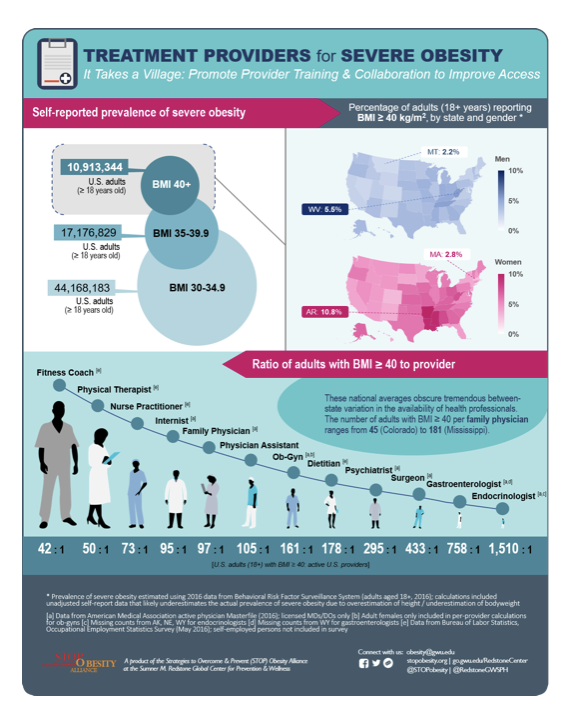Medical professionals are not minted overnight. Health professions grow and transform over decades, not months. While policies and strategies to address America’s chronic diseases shape the healthcare workforce, they are also shaped by it.
In the graphic below, we used 2016 data from the Behavioral Risk Factor Surveillance System and the American Medical Association’s State Physician Workforce Data Book to estimate the availability and distribution of potential obesity care providers for individuals with severe obesity.
These data highlight two important conclusions:
Treatment is essential but will not resolve the obesity epidemic.
Our data reflect provider ratios only for adults with severe obesity (BMI ≥ 40 kg/m2). If we include adults with BMI ≥ 35, these ratios nearly triple. Few primary care providers are equipped with the knowledge, training, and resources needed to comprehensively care for adults with severe obesity. Even when competent providers exist, pervasive weight bias and limited reimbursement for effective obesity treatments deters many individuals with severe obesity from seeking care. Both population-level interventions that prevent excessive weight gain and effective treatments for individuals with severe obesity are crucial to reduce obesity-related morbidity and mortality.
Scalable treatments will require involvement of non-physician providers.
Costs and coverage aside, the looming physician shortage may prove particularly problematic for treatment that relies heavily on MDs and DOs. Although the number of board-certified obesity medicine specialists has tripled since 2014, only 2,656 diplomates exist nationwide. The ratio of approximately 4,000 adults with severe obesity per obesity medicine specialist emphasizes that other care providers will need to be engaged in obesity management. Such providers could come from a variety of backgrounds, but will need to be trained to provide compassionate, competent care for individuals with obesity as part of an interprofessional team. Such training should include the competencies that we developed for the prevention and treatment of obesity.
Obesity care is unlikely to be identical across localities given the tremendous disparities in the geographic distribution of obesity and provider types. Effective telehealth delivery systems may help to alleviate gaps in obesity care. Regardless of provider type, a key issue is that all providers should understand when care should be escalated and who can provide more aggressive care.



